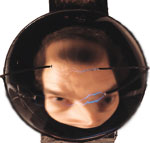The electric non-being
Costis Triandaphyllou continues his adventure with simulacrums, today it leads to the
atmospheric electric universe and the referential, allusive and poetical consequences
which such an intrusion implies. It is obviously an intrusion to enter the domain of lightning and
thunder. Costis identifies with Prometheus, he appropriates fire and shapes it according
to his wishes. The results are fascinating. Lightning defines itself as an electrical
output in the atmosphere. It can be distinguished by the quality of its brightness. It can
be sinuous, arborescent or even form a system of halos as heat waves do. Lightning,
according to Costis, is in every way synthetic. It is mental because it belongs to
probabilities of the elaboration of an electronic programme, its random emergence is akin
to the same probability in perception that we are able to acknowledge as on this copper
sheet on which the light of the electronic output is engraved.
It is obviously an intrusion to enter the domain of lightning and
thunder. Costis identifies with Prometheus, he appropriates fire and shapes it according
to his wishes. The results are fascinating. Lightning defines itself as an electrical
output in the atmosphere. It can be distinguished by the quality of its brightness. It can
be sinuous, arborescent or even form a system of halos as heat waves do. Lightning,
according to Costis, is in every way synthetic. It is mental because it belongs to
probabilities of the elaboration of an electronic programme, its random emergence is akin
to the same probability in perception that we are able to acknowledge as on this copper
sheet on which the light of the electronic output is engraved.
The probability of the image is conceived by us as a demonstration of non-being - as
opposed to being. According to Hegel’s definition, non-being is the intermediate
position between being and nothingness which relieves the hypertrophy of the
"self" and creates a random openness to fanciful poetry, to rational speech.  LCostis’
fantasy is always recuperated under the sign of 3=1. It is no longer simulacrums of faces
that are challenged, but electric alternances. Costis’ recent work called 3=1 stages
linear elements forming with tremors a visual and illuminating trinity. Fantasy, is also
an explosive game, a game with thunder, a game with all the spectacular elements in an
ethereal fire. I think that Costis’ behaviour is a profession of great modesty
regarding the problem he is confronting. And in some way, this modesty identifies with a
certain exorcism. The sky’s anger doesn’t start in vain and one doesn’t
risk playing with lightning for no reason. And I don’t think that Costis - primary
technology helped him tame lightning - draws a vain glory of it. I have never felt so
strongly such respect toward manipulated energy containing such a fundamental discourse.
Costis knows very well that he can overtake this energy from the sky and the cosmos to
assimilate and integrate it in a poetical discourse. He also knows that he isn’t the
owner, he is only the inspired «renter» who acknowledges this invisible cosmic and
nevertheless omnipresent energy that surrounds us. Being aware that energy is the basis of
every expression of language and most of all the basis of all the criteria of definition,
of sensitivity- acts autonomously.
LCostis’
fantasy is always recuperated under the sign of 3=1. It is no longer simulacrums of faces
that are challenged, but electric alternances. Costis’ recent work called 3=1 stages
linear elements forming with tremors a visual and illuminating trinity. Fantasy, is also
an explosive game, a game with thunder, a game with all the spectacular elements in an
ethereal fire. I think that Costis’ behaviour is a profession of great modesty
regarding the problem he is confronting. And in some way, this modesty identifies with a
certain exorcism. The sky’s anger doesn’t start in vain and one doesn’t
risk playing with lightning for no reason. And I don’t think that Costis - primary
technology helped him tame lightning - draws a vain glory of it. I have never felt so
strongly such respect toward manipulated energy containing such a fundamental discourse.
Costis knows very well that he can overtake this energy from the sky and the cosmos to
assimilate and integrate it in a poetical discourse. He also knows that he isn’t the
owner, he is only the inspired «renter» who acknowledges this invisible cosmic and
nevertheless omnipresent energy that surrounds us. Being aware that energy is the basis of
every expression of language and most of all the basis of all the criteria of definition,
of sensitivity- acts autonomously.
This sensitivity which is ours, and the demonstration of our identity is only a minute
part in cosmic energy. Once again it is lent to us, we don’t own it. So we are
responsible for that loan and it is the quality of responsibility in our awareness that
Costis wants to underline permanently with the expression of his electrical language. I
think there is in this attitude a great love of humanity, and a great hope regarding the
great alchemy of the world with its redemption and salvation. According to traditional
alchemy lightning occurs at the term of the igneous way, the determining element in the
planetary salvation and the philosophers’ stone, the demonstration announcing the
catalysis by fire changing lead into gold and producing the world’s final salvation.
We are no doubt too rational as we only notice in this electric approach the search of a
poetical and probably illusory Grail. But this kind of illusion is particularly necessary
for us, it helps us live, without giving us false illusions of being better. All of
Costis’ exhibition appears as a great metaphor of energy. A metaphor with enough
symbolical references for it to open on to a moral universe. A moral metaphor is a
parable.
 Costis’
imagination is a double parable in the physical sense of the term : the brightness of
lightning itself. And in a moral sense all these works resemble fables, and like all
fabulous parables, they point to the morality of the being. This concept of being is not
imposed on us in the name of good and bad manicheism, on the contrary it is left loose, as
the process of a thought. This is so true that this recall to essential consciousness is a
second degree recall which actually appears only with the photos of Costis’
sculptures : these sculptures - which are concave mirrors on stems - are responsible for
the electrical output, and what they reveal to a bare eye is lightning with linear winding
accompanied by the sound of thunder but nothing more. The photo of the lightning-event
releases a dialectic component of this essential phenomenon : the reverberation of the
electric light, a sky-blue reverberation which is the homothetic projection of the
fleeting trace of the created lightning. Dualism, dear to the nature of the Greek
sculptor, is recognised at the same time as the confession of a truth which belongs more
to existence than to essence itself. Being can only be conceived in relation to non-being.
Costis’
imagination is a double parable in the physical sense of the term : the brightness of
lightning itself. And in a moral sense all these works resemble fables, and like all
fabulous parables, they point to the morality of the being. This concept of being is not
imposed on us in the name of good and bad manicheism, on the contrary it is left loose, as
the process of a thought. This is so true that this recall to essential consciousness is a
second degree recall which actually appears only with the photos of Costis’
sculptures : these sculptures - which are concave mirrors on stems - are responsible for
the electrical output, and what they reveal to a bare eye is lightning with linear winding
accompanied by the sound of thunder but nothing more. The photo of the lightning-event
releases a dialectic component of this essential phenomenon : the reverberation of the
electric light, a sky-blue reverberation which is the homothetic projection of the
fleeting trace of the created lightning. Dualism, dear to the nature of the Greek
sculptor, is recognised at the same time as the confession of a truth which belongs more
to existence than to essence itself. Being can only be conceived in relation to non-being.
 Back...
Back...

© ART TOPOS, 1996
Last update: 22 July 1996
info@artopos.org
 It is obviously an intrusion to enter the domain of lightning and
thunder. Costis identifies with Prometheus, he appropriates fire and shapes it according
to his wishes. The results are fascinating. Lightning defines itself as an electrical
output in the atmosphere. It can be distinguished by the quality of its brightness. It can
be sinuous, arborescent or even form a system of halos as heat waves do. Lightning,
according to Costis, is in every way synthetic. It is mental because it belongs to
probabilities of the elaboration of an electronic programme, its random emergence is akin
to the same probability in perception that we are able to acknowledge as on this copper
sheet on which the light of the electronic output is engraved.
It is obviously an intrusion to enter the domain of lightning and
thunder. Costis identifies with Prometheus, he appropriates fire and shapes it according
to his wishes. The results are fascinating. Lightning defines itself as an electrical
output in the atmosphere. It can be distinguished by the quality of its brightness. It can
be sinuous, arborescent or even form a system of halos as heat waves do. Lightning,
according to Costis, is in every way synthetic. It is mental because it belongs to
probabilities of the elaboration of an electronic programme, its random emergence is akin
to the same probability in perception that we are able to acknowledge as on this copper
sheet on which the light of the electronic output is engraved.  LCostis’
fantasy is always recuperated under the sign of 3=1. It is no longer simulacrums of faces
that are challenged, but electric alternances. Costis’ recent work called 3=1 stages
linear elements forming with tremors a visual and illuminating trinity. Fantasy, is also
an explosive game, a game with thunder, a game with all the spectacular elements in an
ethereal fire. I think that Costis’ behaviour is a profession of great modesty
regarding the problem he is confronting. And in some way, this modesty identifies with a
certain exorcism. The sky’s anger doesn’t start in vain and one doesn’t
risk playing with lightning for no reason. And I don’t think that Costis - primary
technology helped him tame lightning - draws a vain glory of it. I have never felt so
strongly such respect toward manipulated energy containing such a fundamental discourse.
Costis knows very well that he can overtake this energy from the sky and the cosmos to
assimilate and integrate it in a poetical discourse. He also knows that he isn’t the
owner, he is only the inspired «renter» who acknowledges this invisible cosmic and
nevertheless omnipresent energy that surrounds us. Being aware that energy is the basis of
every expression of language and most of all the basis of all the criteria of definition,
of sensitivity- acts autonomously.
LCostis’
fantasy is always recuperated under the sign of 3=1. It is no longer simulacrums of faces
that are challenged, but electric alternances. Costis’ recent work called 3=1 stages
linear elements forming with tremors a visual and illuminating trinity. Fantasy, is also
an explosive game, a game with thunder, a game with all the spectacular elements in an
ethereal fire. I think that Costis’ behaviour is a profession of great modesty
regarding the problem he is confronting. And in some way, this modesty identifies with a
certain exorcism. The sky’s anger doesn’t start in vain and one doesn’t
risk playing with lightning for no reason. And I don’t think that Costis - primary
technology helped him tame lightning - draws a vain glory of it. I have never felt so
strongly such respect toward manipulated energy containing such a fundamental discourse.
Costis knows very well that he can overtake this energy from the sky and the cosmos to
assimilate and integrate it in a poetical discourse. He also knows that he isn’t the
owner, he is only the inspired «renter» who acknowledges this invisible cosmic and
nevertheless omnipresent energy that surrounds us. Being aware that energy is the basis of
every expression of language and most of all the basis of all the criteria of definition,
of sensitivity- acts autonomously.  Costis’
imagination is a double parable in the physical sense of the term : the brightness of
lightning itself. And in a moral sense all these works resemble fables, and like all
fabulous parables, they point to the morality of the being. This concept of being is not
imposed on us in the name of good and bad manicheism, on the contrary it is left loose, as
the process of a thought. This is so true that this recall to essential consciousness is a
second degree recall which actually appears only with the photos of Costis’
sculptures : these sculptures - which are concave mirrors on stems - are responsible for
the electrical output, and what they reveal to a bare eye is lightning with linear winding
accompanied by the sound of thunder but nothing more. The photo of the lightning-event
releases a dialectic component of this essential phenomenon : the reverberation of the
electric light, a sky-blue reverberation which is the homothetic projection of the
fleeting trace of the created lightning. Dualism, dear to the nature of the Greek
sculptor, is recognised at the same time as the confession of a truth which belongs more
to existence than to essence itself. Being can only be conceived in relation to non-being.
Costis’
imagination is a double parable in the physical sense of the term : the brightness of
lightning itself. And in a moral sense all these works resemble fables, and like all
fabulous parables, they point to the morality of the being. This concept of being is not
imposed on us in the name of good and bad manicheism, on the contrary it is left loose, as
the process of a thought. This is so true that this recall to essential consciousness is a
second degree recall which actually appears only with the photos of Costis’
sculptures : these sculptures - which are concave mirrors on stems - are responsible for
the electrical output, and what they reveal to a bare eye is lightning with linear winding
accompanied by the sound of thunder but nothing more. The photo of the lightning-event
releases a dialectic component of this essential phenomenon : the reverberation of the
electric light, a sky-blue reverberation which is the homothetic projection of the
fleeting trace of the created lightning. Dualism, dear to the nature of the Greek
sculptor, is recognised at the same time as the confession of a truth which belongs more
to existence than to essence itself. Being can only be conceived in relation to non-being.